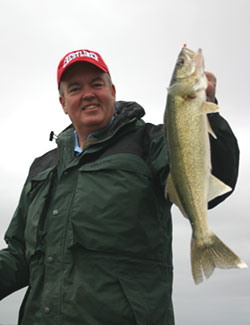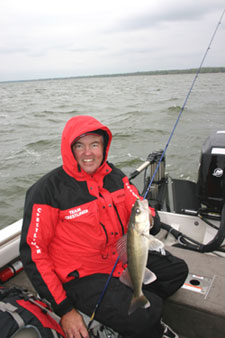 Opening day may be quite a ways off but it’s not too soon to start thinking about how exactly you’re going to put a few extra walleyes in the boat. A little pre-opener thought can help you put together a winning game plan, a plan that includes some catching and no matter what they say; catching is a major part of a quality experience.
Opening day may be quite a ways off but it’s not too soon to start thinking about how exactly you’re going to put a few extra walleyes in the boat. A little pre-opener thought can help you put together a winning game plan, a plan that includes some catching and no matter what they say; catching is a major part of a quality experience.
Exactly where you stake your claim is a big part of a solid plan and may not even be a consideration if you’re already locked in to a specific body of water. In that case you’ll have to try and make do (no matter what the conditions), and adjust to whatever Mother Nature dishes out. Flexibility on the other hand can give you a much better shot at putting a few more fish in the boat. A good boat trailer and being flexible allows for last minute adjustments, and may help to put you in the enviable position of being in the right place at the right time. Being in the right place at the right time is more than just dumb luck, although a little luck never hurts. In fact it’s more a matter of reading the conditions and reacting accordingly, which can put you well on your way to finding the season’s first hot spot.
Hot lakes and hot spots can vary from year to year and it seldom pays to get caught up in chasing memories. Variances in populations of walleyes and baitfish can have a dramatic effect on the activity levels of your intended victims and a number of things have to come together to get the odds in your favor.
For one, you need an appreciable number of walleyes to have a chance. Sounds simple enough but prior years of poor spawning conditions may have some year classes coming up a little short and if you’re dealing with slot limitations a couple of missing year classes may send you home empty handed.
The amount of available bait a system is carrying can also have a definitive effect, with a shortage being a huge advantage and a surplus being a detriment. Combine a burgeoning walleye population with a shortage of bait and you’re in the driver’s seat. On the other hand when a predator low and a high biomass of bait comes together a Shorelandr’ really becomes important. Predicting highs and lows is way over the average angler’s head and falls more into the realm of the professional biologists, and even they have trouble with the process. One thing you can do is look for trends, and realize that trends are not usually short lived. For example; a good fall is usually followed by a good winter and spring. A tough fall and winter on the other hand can translate into a tough spring and summer, but not always. About the only thing you can take away from it all is that it does happens, and if you’ve exhausted all of your options with little or no success a change in venue may be in order.
 Another key factor affecting success on the opener is the type of spring we’ve been handed with warm and consistent being preferred. A big warm up before the opener can make good things happen for everybody, and the whole process becomes a lot easier. A cold erratic spring can make for some of the toughest conditions and where the cream really rises to the top. The most successful anglers have back up plans, plans that they’ve discovered through trial and error and from years of on the water experience. One of the things they’ve probably discovered is that shallow dark water lakes are their best bet when up against some of the toughest conditions. For whatever reason the darker shallow lakes can keep on kicking out fish, even under the adverse effects of an unusually cold spring or after the passing of a severe cold front. A logical explanation may be the fact that dark shallow lakes warm up faster than deeper colder ones, and a bump in temperature of a few degrees can make a world of difference.
Another key factor affecting success on the opener is the type of spring we’ve been handed with warm and consistent being preferred. A big warm up before the opener can make good things happen for everybody, and the whole process becomes a lot easier. A cold erratic spring can make for some of the toughest conditions and where the cream really rises to the top. The most successful anglers have back up plans, plans that they’ve discovered through trial and error and from years of on the water experience. One of the things they’ve probably discovered is that shallow dark water lakes are their best bet when up against some of the toughest conditions. For whatever reason the darker shallow lakes can keep on kicking out fish, even under the adverse effects of an unusually cold spring or after the passing of a severe cold front. A logical explanation may be the fact that dark shallow lakes warm up faster than deeper colder ones, and a bump in temperature of a few degrees can make a world of difference.
You can also try following the warmer temps no matter what body of water you happen to be on. With a graph like the Humminbird 997c which has a built in surface temperature gauge you can get a quick reading and know whether you should move on or dig in. The north side of a lake is a good place to start looking but even a bone chilling northwest wind that is warmer than the current water temps can still push up and concentrate pockets of warm water on the south and east sides.
After you’ve honed in on the warmest water the next step is to look for likely early season spots within the pockets of extra heat. A great early season hot spot would be a sandy shoreline flat with some rock and gravel thrown in for good measure. Combine it with warmer water and maybe some wind and you’ve got a potential hot spot that’s darn near a lead pipe cinch.
One of the problems associated with working the warmer water is it’s usually catching the brunt of the heaviest wind and the tallest waves and you better be prepared if you plan on digging in. For starters; your craft better be up to the task and why I’ll be running an 1800 Crestliner Super Hawk this season. Its length combined with nice high sides and a deep V will allow me to safely run on a variety of lakes from big to small. You may also need some specialized equipment to keep it all under control. Cold water temps usually dictate dead slow presentations like rigging and jigging , and is where a simple item like a drift sock can prove to be invaluable. A drift sock can slow a boat down to a crawl, and may be just the ticket to triggering early season cold water ‘eyes. In the roughest stuff a large sock off the bow and a smaller one near the transom may be in necessary.
There will be times when you put it all together and you’re doing the right things in the right places but you’re timing is a little off. Leaving fish that turn on after you’ve left, or moving in on a school that is just shutting down is part of the program, and beyond your control. On the good days you can do no wrong and finding active fish seems as easy as falling off a log. Those are the days to really appreciate, as they are rare indeed.
See you on the water.










